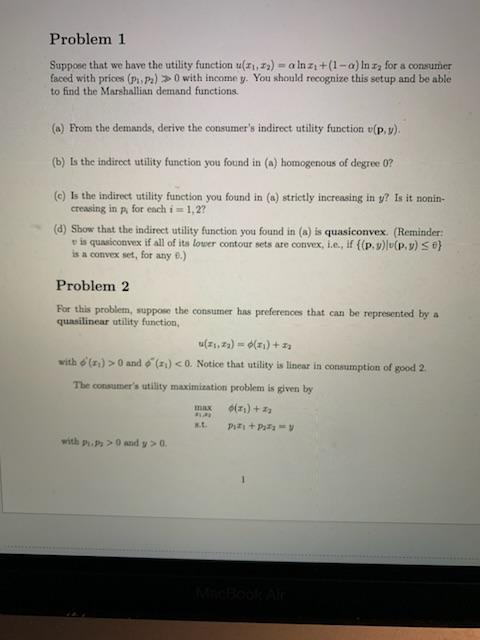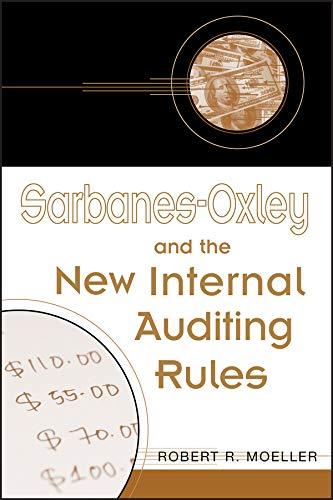
Suppoee that we have the utility function u(x1,x2)=lnx1+(1)lnx2 for a consumier faced with prios (p1,P2)>0 with income y. You should recognize this setup and be able to find the Marshallian demand functions. (a) From the demands, derive the consumer's indirect utility function v(P,y). (b) Is the indiroct utility function you found in (a) homogenous of degree 0? (c) Is the indirect utility function you found in (a) strictly increasing in y ? is it nonincreasing in p for each i=1,2 ? (d) Sbow that the indirect utility function you found in (a) is quasiconvex. (Reminder: v is quasiconvex if all of its lower contour sets ate convex; i.e., if {(p,y)v(p,y)} is a convex set, for any .) Problem 2 For this problem, suppose the consurner has preferences that can be represented by a quasilinear utility function, u(x1,x2)=(x1)+x2 with (x1)>0 and (x1)0 and y>0. Suppose that we have the utility function u(x1,x2)=lnx1+(1)lnx2 for a consumer faced with prices (p1,p2)0 with income y. You should recognize this setup and be able to find the Marshallian demand functions. (a) From the demands, derive the consumer's indirect utility function v(p,y). (b) Is the indirect utility function you found in (a) homogenous of degree 0 ? (c) Is the indirect utility function you found in (a) strictly increasing in y ? Is it nonincreasing in pi for each i=1,2 ? (d) Show that the indirect utility function you found in (a) is quasiconvex. (Reminder: v is quasiconvex if all of its lower contour sets are convex, i.e., if {(p,y)v(p,y)v^} is a convex set, for any v.) Problem 2 For this problem, suppose the consumer has preferences that can be represented by a quasilinear utility function, u(x1,x2)=(x1)+x2 with (x1)>0 and (x1)0 and y>0. (a) Write down the Lagrangian function. (b) Write down each of the first-order conditions for the problem. (c) What do the first-order conditions tell you regarding the value of ? Ordinarily, the value of will depend on p1 and y. Is that the case here? Try to give some interpretation. (d) Use your answer to part (c) and the first-order condition for x1 to derive the Marshallian demand functions. Then, explain whether or not good 1 is a normal good, inferior good, or neutral good. (e) Use the implicit function theorem to compute the partial derivative (comparative static) p1x1(p,y) (f) Explain how you could use the Slutsky equation and your answer to part (d) to predict the sign of the comparative static you found in part (e). (g) Now solve for the Marshallian demand functions under the assumption that (x1)=x10.5. Problem 3 Consider the utility function u(x1,x2)=x10.5+x20.5. (a) Compute the Marshallian demand functions for the two goods. (b) Compute the substitution term in the Slutsky equation for the effect of a change in pr on the demand x1. (c) Can you classify the two goods as gross complements or gross substitutes? Suppoee that we have the utility function u(x1,x2)=lnx1+(1)lnx2 for a consumier faced with prios (p1,P2)>0 with income y. You should recognize this setup and be able to find the Marshallian demand functions. (a) From the demands, derive the consumer's indirect utility function v(P,y). (b) Is the indiroct utility function you found in (a) homogenous of degree 0? (c) Is the indirect utility function you found in (a) strictly increasing in y ? is it nonincreasing in p for each i=1,2 ? (d) Sbow that the indirect utility function you found in (a) is quasiconvex. (Reminder: v is quasiconvex if all of its lower contour sets ate convex; i.e., if {(p,y)v(p,y)} is a convex set, for any .) Problem 2 For this problem, suppose the consurner has preferences that can be represented by a quasilinear utility function, u(x1,x2)=(x1)+x2 with (x1)>0 and (x1)0 and y>0. Suppose that we have the utility function u(x1,x2)=lnx1+(1)lnx2 for a consumer faced with prices (p1,p2)0 with income y. You should recognize this setup and be able to find the Marshallian demand functions. (a) From the demands, derive the consumer's indirect utility function v(p,y). (b) Is the indirect utility function you found in (a) homogenous of degree 0 ? (c) Is the indirect utility function you found in (a) strictly increasing in y ? Is it nonincreasing in pi for each i=1,2 ? (d) Show that the indirect utility function you found in (a) is quasiconvex. (Reminder: v is quasiconvex if all of its lower contour sets are convex, i.e., if {(p,y)v(p,y)v^} is a convex set, for any v.) Problem 2 For this problem, suppose the consumer has preferences that can be represented by a quasilinear utility function, u(x1,x2)=(x1)+x2 with (x1)>0 and (x1)0 and y>0. (a) Write down the Lagrangian function. (b) Write down each of the first-order conditions for the problem. (c) What do the first-order conditions tell you regarding the value of ? Ordinarily, the value of will depend on p1 and y. Is that the case here? Try to give some interpretation. (d) Use your answer to part (c) and the first-order condition for x1 to derive the Marshallian demand functions. Then, explain whether or not good 1 is a normal good, inferior good, or neutral good. (e) Use the implicit function theorem to compute the partial derivative (comparative static) p1x1(p,y) (f) Explain how you could use the Slutsky equation and your answer to part (d) to predict the sign of the comparative static you found in part (e). (g) Now solve for the Marshallian demand functions under the assumption that (x1)=x10.5. Problem 3 Consider the utility function u(x1,x2)=x10.5+x20.5. (a) Compute the Marshallian demand functions for the two goods. (b) Compute the substitution term in the Slutsky equation for the effect of a change in pr on the demand x1. (c) Can you classify the two goods as gross complements or gross substitutes









